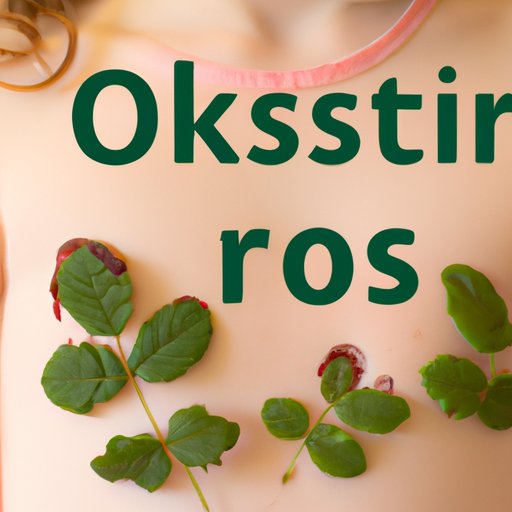Introduction
Poison oak is a plant with leaves that produce an oil containing urushiol, which can cause an allergic reaction known as contact dermatitis when it comes into contact with skin. It’s important to know what poison oak looks like, as well as how to recognize the symptoms of a poison oak rash and how to treat it quickly. In this article, we will discuss what poison oak looks like on skin and provide a visual guide to help you identify it. We will also cover how to recognize the symptoms of a poison oak rash, what parents should know about protecting their children from poison oak, and five ways to treat a poison oak rash.

A Visual Guide to Identifying Poison Oak on the Skin
It’s important to be able to identify poison oak in order to avoid contact with it. The plant typically grows as a shrub or vine and has three pointed leaflets. The leaves are usually green in the spring and summer, turning red or orange in the fall. The bark of the plant is dark brown to gray and can be scaly or smooth. The berries of the plant are white or pale green and grow in clusters.
When trying to differentiate poison oak from other plants, it’s important to note that poison oak does not have thorns, unlike some other plants. Additionally, poison oak leaves tend to be glossy and waxy, while other plants may be more matte. If you come into contact with a plant and are unsure if it is poison oak, it is best to err on the side of caution and avoid touching it.

How to Recognize Symptoms of Poison Oak Rash
If you come into contact with poison oak, you may experience a range of symptoms, including itching, swelling, and redness of the skin. These symptoms usually appear within 24-48 hours after contact, but can take up to a week to appear. Blisters may also form on the skin, which can cause extreme discomfort. In more serious cases, the rash can spread to other parts of the body and cause fever, nausea, and headache.
In these cases, it is important to seek medical attention as soon as possible. If left untreated, the rash can lead to infection, scarring, and even permanent changes in skin color.

What Every Parent Should Know About Poison Oak and Skin
Children are especially vulnerable to poison oak because they are more likely to come into contact with the plant while playing outdoors. Parents should take steps to protect their children from poison oak by teaching them to identify the plant and avoid contact with it. Additionally, parents should inspect their children’s outdoor clothing and gear for traces of the plant and clean and disinfect any items that may have come into contact with it.
If your child does experience a poison oak rash, it is important to seek medical attention as soon as possible. Treatment may include over-the-counter medications, home remedies, prescription topical treatments, oral corticosteroids, and phototherapy.
5 Ways to Treat a Poison Oak Rash
There are a number of ways to treat a poison oak rash, both over-the-counter and prescription. Over-the-counter medications such as hydrocortisone cream, calamine lotion, and antihistamines can help reduce itching and inflammation. Home remedies such as cold compresses and oatmeal baths can also provide relief.
Prescription topical treatments such as creams and ointments containing steroids, antibiotics, or antifungal medications can be used to reduce inflammation and prevent infection. Oral corticosteroids may also be prescribed to reduce inflammation and itching. Phototherapy can also be used in more severe cases to reduce inflammation.
How to Prevent Poison Oak from Spreading
In order to prevent poison oak from spreading, it is important to clean and disinfect any clothing or gear that may have come into contact with the plant. Wash all clothing and gear with hot, soapy water and dry in a hot dryer. Avoiding contact with poison oak is also key; wear long sleeves and pants and use insect repellent when outdoors.
An Expert’s Guide to Identifying Poison Oak on the Skin
Identifying poison oak on the skin can be difficult, as it is often hard to tell the difference between the rash and other skin conditions. Here are a few tips from experts on how to spot poison oak:
- Look for clusters of blisters or bumps on the skin.
- Pay attention to areas of the body that may have come into contact with the plant, such as the arms, legs, and face.
- Be aware of any itching or burning sensation on the skin.
- Check for signs of reddening or discoloration of the skin.
- Listen for any reports of contact with poison oak plants.
By following these tips, you can help identify and treat poison oak early on, before it has a chance to spread.
Conclusion
Poison oak is a plant with leaves that can cause an allergic reaction when it comes into contact with skin. It’s important to know what poison oak looks like and how to recognize the symptoms of a poison oak rash. In this article, we provided a visual guide to help you identify poison oak and discussed how to recognize the symptoms of a poison oak rash, what parents should know about protecting their children from poison oak, and five ways to treat a poison oak rash. Finally, we outlined how to prevent poison oak from spreading and provided tips for spotting poison oak on the skin.
By understanding what poison oak looks like and how to recognize the symptoms of a poison oak rash, you can better protect yourself and your family from this potentially dangerous plant.


